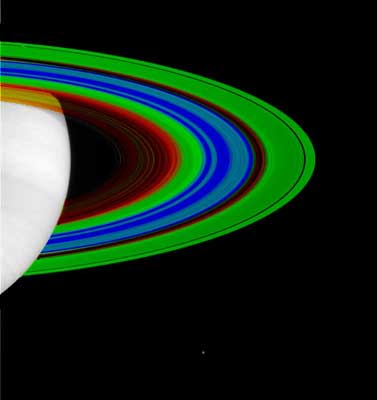The "Cassini" research spacecraft made the most accurate temperature measurements of Saturn's rings. The information collected by the composite infrared spectrometer on the spacecraft when it entered a peripheral orbit around the planet, shows the temperature differences between the rings; The relatively cold and warm areas in the rings

The research spacecraft "Cassini" made the most accurate temperature measurements of Saturn's rings. The information collected by the composite infrared spectrometer on the spacecraft when it entered a peripheral orbit around the planet, shows the temperature differences between the rings; The relatively cold and warm areas in the rings.
In this image the colors are not real, and show the temperatures on the unlit side of the rings; Red: "hot" in the range of -160 degrees Celsius (110 Kelvin), for "cold" - blue: -200 degrees Celsius (70 Kelvin). The green color symbolizes a temperature of about -180 degrees Celsius [90 Kelvin].
The data shows that opaque areas of the rings, such as the outer ring [A ring] and the middle ring [B ring] are colder, while more transparent areas, such as the "Cassini Division" visible between the A and B rings in red, or the C ring The inner one [painted in yellow and red] is warmer. Scientists predicted that this might be the case, because the opaque areas of the ring would let the least light pass through, and the transparent areas would let more. These results show for the first time that individual and distinct ring groups in the C ring and the Cassini split are colder than the opaque regions around them.
The measurements were taken on the first of July, 2004, shortly after Cassini's entry into orbit around Saturn. Today, Cassini is so close to the planet that no images of the dark side of the rings can be taken. Thus, the temperature image was superimposed on the image of the bright side of the rings. This photo was taken with an excessively long exposure, so Saturn appears white. Saturn's moon Enceladus can be seen below the rings, near the bottom center of the image.
The infrared instrument on the spacecraft, one of the twelve instruments on "Cassini", will measure infrared emissions from the atmosphere, rings, and surfaces. This spectrometer will profile the composition of the atmospheres and gases on Titan and Saturn. During Cassini's four-year mission, scientists will gather information about the thermal properties and composition of Saturn's rings and its icy moons.
